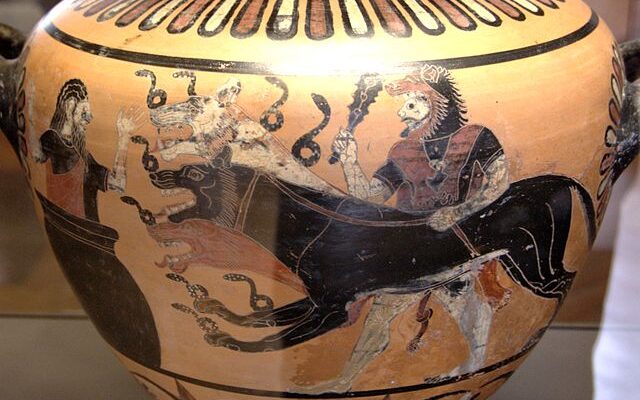
Archeologists in Italy recently uncovered something amazing. Located in in Giugliano, a suburb of Naples, researchers there announced the discovery of a well-preserved burial site that features incredible artwork spanning all of Roman mythology.
Among the most notable mythological figures depicted is that of the three-headed dog said to guard the gates of the underworld, which is why the burial chamber has been dubbed the ‘Tomb of Cerberus,’ writes The Daily Mail
The striking painting represents the 12th and most dangerous of the Labours of Hercules: when he descended to Hades guided by Mercury to capture the three-headed monster dog Cerberus.
Other mythological figures painted on the walls include ichthyocentaurs – a centaurine-type sea god with the upper body of a human and the lower anterior half and fore-legs of a horse and the tail of a fish.
The scene depicted shows two ichthyocentaurs facing each other while holding an ancient Greco-Roman shield.
Each has an erote – a winged Cupid-like baby associated with love and sexual desire – on their arm.
According to one outlet, “the burial chamber was brought to light after archaeologists identified a wall constructed using the ancient Roman method known as opus incertum. Initially, the wall was thought to mark the boundary of a necropolis, but it turned out to be the frontal wall of the chamber tomb, which was meticulously sealed with a slab of tuff, a lightweight, porous rock formed from volcanic ash. To access the inner sanctum of the burial chamber, researchers carefully removed tiles covering the ceiling opening, unveiling what has been described by the Archaeological Superintendency of Naples as an unprecedented find.”
Cerberus, in Greek mythology, is a monstrous three-headed dog with a serpent’s tail. It is famously known as the guardian of the Underworld, the realm of Hades, where the souls of the deceased go after death. Cerberus is often depicted as a fierce and imposing creature, a formidable obstacle for those attempting to enter or leave the Underworld. The most well-known encounter with Cerberus is found in the myth of Heracles (Hercules in Roman mythology) as one of his twelve labors. Heracles was tasked with capturing Cerberus and bringing him to the surface world. Heracles accomplished this feat by using his immense strength to overpower the fearsome dog, temporarily rendering him docile.
Cerberus serves as a symbol of the boundary between the living and the dead. His role as a guardian reflects the ancient Greek belief that the passage into the Underworld was a one-way journey, and the presence of Cerberus ensured that those who entered could never return to the world of the living. The myth of Cerberus has continued to influence art, literature, and popular culture, and it remains one of the most iconic figures in Greek mythology.










Find more allover the ex Old Roman Empire in EU & No Africa too